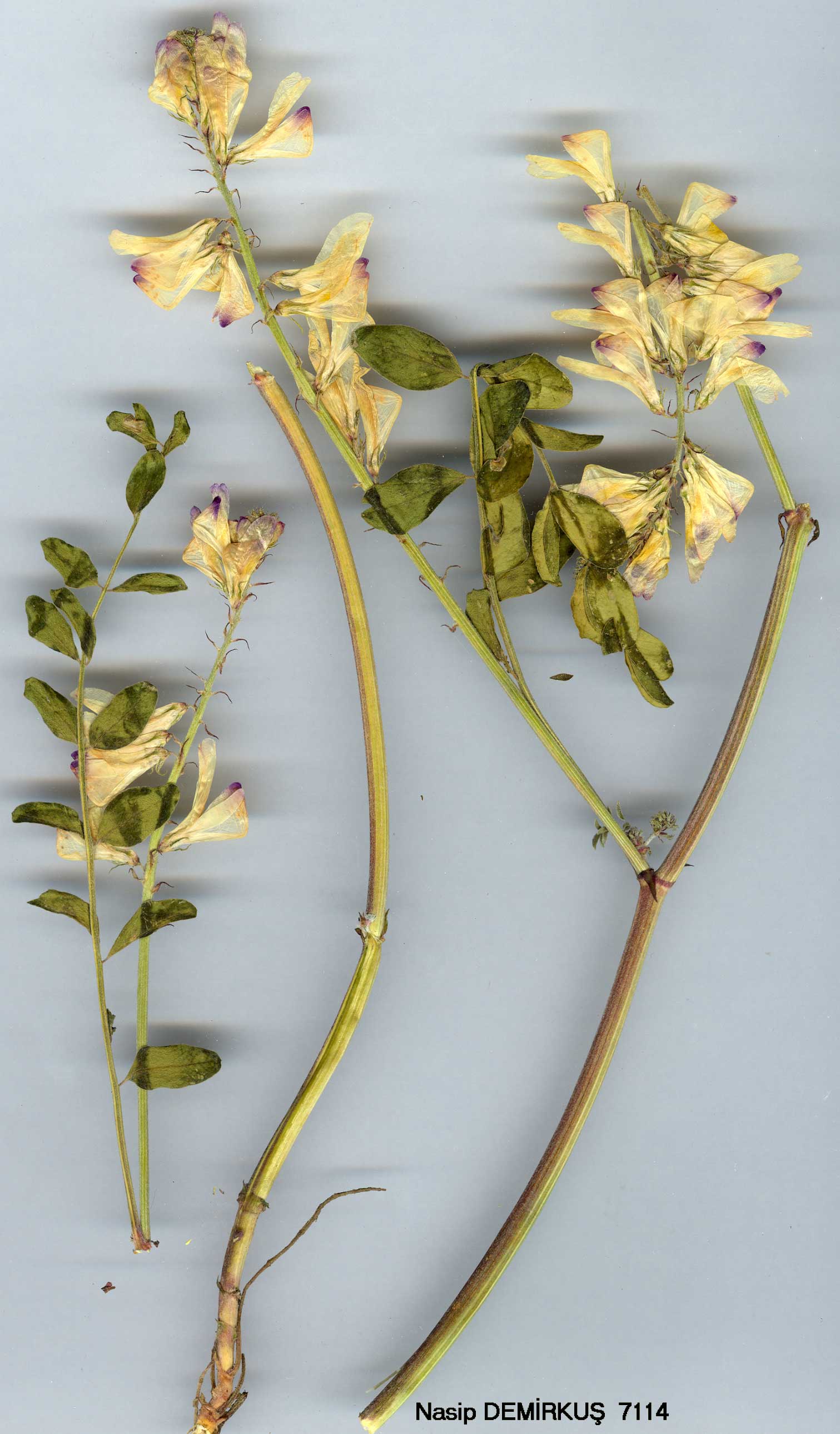| Fabaceae |
|---|

Hedysarum varium WILLD. |
 Hedysarum varium WILLD. |
Hedysarum L. |
| H. varium Willd., Sp. P1. 3:1206 (1800). Syn: H. lydium Boiss., Diagn. ser. 1 (2): 88 (1843)! H. callichroum Boiss., I.c. 89! H. sipyleum Boiss., I.c. 89! H. dume-torum Boiss. &Heldr. in Boiss., Diagn. ser. 1(9): 111 (1849)! H. phrygium Boiss. & Bal. in Boiss., Diagn. ser. 2(6): 66 (1859)! H. ancyrense Freyn in Bull. Herb. Boiss. 3:266 (1901). Figure 15, p. 585. Stems erect or ascending, branched, 15-40 cm. Leaves with 4-9 pairs of oblong or oblong-elliptic leaflets, 5-20 x 2-8 mm, glabrous or subglabrous above, below with an adpressed pilose indumentum of varying density; stipules brown, scarious. Peduncles longer than leaves. Racemes up to 20-flowered, lax or dense, ovate or oblong, elongating in fruit. Calyx 4-9 mm, with teeth equal to, shorter or longer than tube. Corolla yellow or purplish-yellow; standard (12-)14-23 mm, glabrous or slightly pilose; wings 11-18 mm; keel 11-19 mm. Ovary glabrous,. sparsely or clearly pilose. Lomentum with 2-3 round or ovate segments, rugosewith bristly setae, pilose or subglabrous. Fl. 6-7. Steppe, bare slopes, Quercus woodland, fallow fields, cultivated ground, 300-2100 m. Type: Armenia, Tournefort (B, Hb. Willd., photo!). Widespread except in S.E. Anatolia. A1(E) Çanakkale: Gelibolu, Ingoldby 357. A2 Bilecik: 5-10 km N of Bilecik, 300 m, D. 36362! A3 Ankara: Beypazari, Kühne 604! A4 Çankiri: Çakmakli-dere, 800 m, Bornm. 14030! A5 Amasya: Merzifon to Kadar, 1000 m, Alpay 290! A7 Gümüşane: Gümüşane, 1100 m, Balls 1700! A9 Kars: E of Kağizman, 2100 m, D. 46783! B1 Manisa: Sipylos (Manisa Da.), Boiss.! B2 Uşak: Uşak, Balansa (type of H. phrygium)! B3 Konya: Sultandagh, 1100 m, Bornm. 1899:4314! B4 Ankara: Beynam wood, 1200 m, Markgraf 11036! B5 Kayseri: Pinarbaşi to Göksun, 1750 m, Alpay 289! B6 Sivas: Sivas, 1200 m, Stn. & Hend. 5366! C2 Denizli: Çukur Köy to Tavas near Sarova, 1150 m, Hub.-Mor. 5037! C3/4 Konya: Beyşehir to Konya, Heldr. 833! Ç4 Konya: 11 km S of Ermenek, 1100 m, Hub.-Mor. 9835! C5 Adana: Burujik (Bürücek), Balls 1292! C6 Gaziantep: Kilis, Haradj. 4454! C7 Urfa: Urfa, Kotschy 18! Balkans (?), Gaucasia. Ir.-Tur. element. The most common, widespread and polymorphic species of the genus in Turkey. In the characters of size, shape and number of leaflets, indumentum, flower colour, size, shape and proportions of standard, wings and keel, and shape and indumentum of the lomentum, it is extremely variable. Although H. varium itself is a most polymorphic species, its pattern of variation may be further extended by hybridisation or introgression with H. pestalozzae, H. syriacum, and H. nitidum. The differences between these four species are unsatisfactory, and further work is needed before their interrelationships and taxonomy can be put on sounder foundations. |